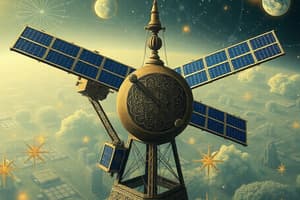Podcast
Questions and Answers
Which line is the most popular T-carrier line used for Internet connections?
Which line is the most popular T-carrier line used for Internet connections?
- T3 Line
- Fractional T1
- ATM
- T1 Line (correct)
Fractional T1 lines are faster than dedicated T1 lines.
Fractional T1 lines are faster than dedicated T1 lines.
False (B)
What is equal in speed to 28 T1 lines?
What is equal in speed to 28 T1 lines?
T3 line
ATM (Asynchronous Transfer Mode) is used for carrying ___, data, video, and multimedia at high speeds.
ATM (Asynchronous Transfer Mode) is used for carrying ___, data, video, and multimedia at high speeds.
Who are the main users of T3 lines?
Who are the main users of T3 lines?
ATM is predicted to replace T3 lines as the Internet standard for data transmission.
ATM is predicted to replace T3 lines as the Internet standard for data transmission.
What is GPS?
What is GPS?
Which of the following are components of a GPS receiver? (Select all that apply)
Which of the following are components of a GPS receiver? (Select all that apply)
GPS technology is only used for navigation.
GPS technology is only used for navigation.
How does a GPS receiver determine its location?
How does a GPS receiver determine its location?
What is geocaching?
What is geocaching?
What do participants do when they find a geocache?
What do participants do when they find a geocache?
What is collaborative software?
What is collaborative software?
Which of the following is an example of a document management system?
Which of the following is an example of a document management system?
Groupware is designed to facilitate communication among groups of people over a network.
Groupware is designed to facilitate communication among groups of people over a network.
What is the Public Switched Telephone Network (PSTN)?
What is the Public Switched Telephone Network (PSTN)?
Which of the following lines is a type of dedicated line?
Which of the following lines is a type of dedicated line?
Flashcards are hidden until you start studying
Study Notes
Global Positioning Systems (GPS)
- GPS is a navigation system that uses satellite signals to determine geographic locations.
- A GPS receiver consists of an antenna, radio receiver, processor, and may include a display screen.
- GPS technology has widespread applications: navigation (vehicles, boats, airplanes), mapping, location-based services, tracking, precision agriculture, and emergency services.
- The basic function of GPS is to help users ascertain their location, calculate routes, find lost items, and monitor movements.
GPS Signal Processing
- GPS satellites orbit Earth continuously, sending signals indicating their position.
- To determine location, a GPS receiver must analyze signals from at least three satellites, performing calculations based on their positions.
Geocaching
- Geocaching is a real-world treasure hunting game utilizing GPS-enabled devices, where participants hide and seek containers (caches).
- Caches are logged with GPS coordinates online, enabling players to locate them using their GPS devices.
- The first documented cache occurred in 2000, with over 900,000 geocaches reported globally, promoting outdoor recreation and adventure.
Collaboration Software
- Collaborative software enables real-time document sharing and communication among users, often through web conferences.
- Document management systems store and manage a company's documents, allowing access based on user needs and tracking updates.
- Google Docs is a notable example of web-based document management, facilitating simultaneous user editing.
Groupware
- Groupware promotes collaboration among users over a network, offering tools for communication, project management, scheduling, and decision making.
- It often includes Personal Information Manager (PIM) functions like calendars and address books.
- A key feature is group scheduling, aiding in coordinating meetings among multiple users.
Voice Mail
- Voice mail systems digitize and store messages, allowing users to leave and manage voice messages in mailboxes on hard disks.
- Visual voice mail enables users to view message details and sometimes read contents without listening.
Web Services
- Web services allow applications to communicate over the internet or internal networks, enhancing business interactions.
- Mashups combine services from different sources to create new applications, like linking e-commerce locations with mapping services.
Communications Software
- Communications software facilitates data exchange over networks and encompasses various applications like email, chat rooms, and VoIP.
- Some software aids users in establishing connections to the internet and configuring networks for home or small offices.
Telephone Network Communications
- The Public Switched Telephone Network (PSTN) is the global system for handling voice calls, primarily using digital technology.
- Dial-up lines are temporary connections using analog phone lines; dedicated lines offer always-on connections for improved quality.
Digital Dedicated Lines
- Various digital dedicated lines include ISDN, DSL, FTTP, T-carrier lines, and ATM, providing faster data transfer rates.
- ISDN enables faster digital transmission over standard phone lines but is less common today.
- DSL uses existing copper telephone wiring for high-speed access, with ADSL favoring downstream speed for users.
- FTTP employs fiber-optic cable for extremely high-speed connections, often leading to home or business locations.
- T-carrier lines support multiple signals on a single line, with T1 and T3 being notable examples used by businesses for strong internet connections.
- ATM offers high-speed transmission of voice, data, video, and multimedia, and is anticipated to become the standard for internet data transmission.
Studying That Suits You
Use AI to generate personalized quizzes and flashcards to suit your learning preferences.




